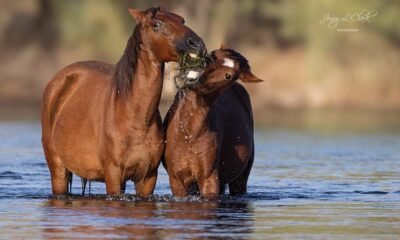amateur
Inside America’s Most Dangerous Sport: Enhanced Safety Measures for Riders and Horses

WILLCOX – Contrary to popular belief, rodeo may be more perilous than football, a sport notorious for its head injuries. Participants in rodeo events, whether bull riding or horse riding, face significant risks. The statistics reveal a sobering truth: the injury rate in bull riding exceeds that of football by over 10 times and is 13 times higher than in ice hockey.
“I’ve had my fair share of falls,” rodeo supervisor Larrie Todd acknowledged. Injuries in rodeo commonly include bruises, sprains, and concussions. A comprehensive study by the Canadian Academy of Sport Medicine highlighted a fatality rate of 4.05 per 100,000 competitors.
Recently, the Willcox West Fest Ranch Rodeo & Chuck Wagon Cook-Off attracted athletes and spectators to Willcox, a town of over 3,000 located just past Tucson on Interstate 10. Unlike many formal competitions, this event operated with minimal protective measures, relying heavily on the skill and instincts of the participants.
“Confidence is crucial,” stated rodeo princess Adelaide Werkheiser. “If I’m not confident, my body reflects that, which can lead to mistakes.” This sentiment underscores the deep connection riders often have with their horses, as their success relies on mutual trust.
Research shows horses can sense emotional cues from their riders. A study from the University of Sussex found that horses can differentiate between happy and angry human expressions, further illustrating the importance of a rider’s mental state.
“Building a relationship with your horse is essential,” Todd emphasized. Many rodeo participants grow up around ranches, often beginning their riding journey before they can walk. Werkheiser, who has been in the rodeo community for ten years, exemplifies this dedication.
This year’s Willcox rodeo held special significance as it honored the memory of Jeff Collup, a local man who passed away unexpectedly in December 2024. Organizer Cheryl Moss, who faced her own tragedy with the loss of her son, emphasized the community’s support during difficult times.
The rodeo continues to evolve by implementing protective measures. Modern vests made from high-density foam and remarkably strong materials are now commonly used to enhance rider safety. Additionally, the introduction of helmets, once a rarity, has significantly reduced the incidence of severe head injuries among participants.
Despite these advancements, rodeo remains an inherently risky endeavor. Participants acknowledge the unpredictable nature of the sport, with potential accidents around every corner. However, all contestants are now required to wear safety equipment according to regulations set by organizations like the National High School Rodeo Association.
The welfare of the animals is also a priority. The Professional Rodeo Cowboys Association has established over 60 animal welfare rules, ensuring the protection of livestock during events. A recent study showed an injury rate of only 0.056% for animals, boasting a safety record that many other sports cannot match.
“Safety is paramount,” Baltierrez noted, highlighting how riders prioritize their horses’ well-being. Beyond the physical risks, rodeo captures the hearts of many, fostering a community spirit that thrives even in adversity.
As participation continues to grow, the rodeo scene in Arizona is on the rise. Both youth and professional categories see increased interest, reflecting the sport’s rich traditions and enduring appeal. With support from local communities, the rodeo is set for a promising future, navigating its unique challenges along the way.
















